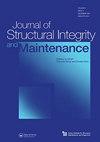热损伤混凝土与碳纤维增强聚合物片材粘结性能的有限元模拟
IF 3.1
Q2 ENGINEERING, CIVIL
Journal of Structural Integrity and Maintenance
Pub Date : 2023-04-03
DOI:10.1080/24705314.2023.2168398
引用次数: 0
摘要
在本研究中,建立了几个有限元(FE)模型,并使用实验数据验证了热损伤混凝土与碳纤维增强聚合物(CFRP)之间的粘结行为。考虑了混凝土抗压强度、碳纤维布宽度和长度、碳纤维布层数(1层、2层和3层)和热暴露水平等参数。以宽150mm、高150mm、跨长300mm的混凝土砌块为研究对象,采用不同配置的碳纤维布对其进行加固,通过单次剪切试验研究其粘结性能。结果与调查研究结果吻合较好。本研究结果表明,温度超过500°C, CFRP片材与混凝土之间的粘结性能明显恶化。此外,在300°C温度下的某些情况下,特别是在室温下具有最高抗压强度的混凝土试件,极限粘结载荷略有增强。最后,通过数值研究为Diab和Farghal(2014)的粘结模型建立修正因子,以考虑高温暴露对混凝土损伤的影响。本文章由计算机程序翻译,如有差异,请以英文原文为准。
Finite element modeling of bond behavior between heat-damaged concrete and carbon fiber-reinforced polymer sheets
ABSTRACT In this study, several finite element (FE) models were constructed and validated with data from experiments that focused on bond behavior between heat-damaged concrete and carbon fiber–reinforced polymer (CFRP). Different parameters as the compressive strength of concrete, CFRP width and length, number of CFRP layers (one, two and three layers) and heat exposure level were considered. A concrete block of 150 mm width, 150 mm height and 300 mm span length strengthened using different configurations of CFRP sheets was used to investigate the bond behavior by means of single shear test. The results show a good congruence with the investigated studies. The results of this study showed that beyond a temperature of 500°C, there was a considerable deterioration in bond properties between CFRP sheets and concrete. Also, a slight enhancement in ultimate bond load was noticed for some cases at temperature of 300°C, especially for concrete specimens having highest compressive strength at room temperature. Finally, numerical study was performed to develop modification factor to Diab and Farghal (2014) bond model to account for effects of damage of concrete due to high temperature exposure.
求助全文
通过发布文献求助,成功后即可免费获取论文全文。
去求助
来源期刊

Journal of Structural Integrity and Maintenance
ENGINEERING, CIVIL-
CiteScore
3.90
自引率
9.50%
发文量
24
 求助内容:
求助内容: 应助结果提醒方式:
应助结果提醒方式:


